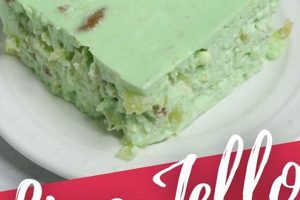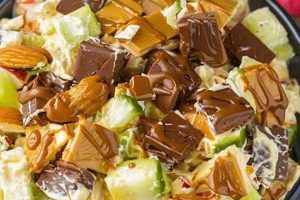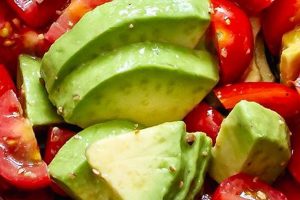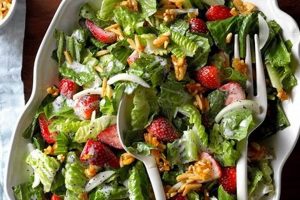A true Nioise salad, originating from Nice, France, traditionally features fresh tomatoes, hard-boiled eggs, olives, anchovies or tuna, and a simple vinaigrette. Green beans and potatoes, while common additions, spark debate among culinary purists. Variations may incorporate other vegetables like bell peppers or artichoke hearts. However, lettuce is notably absent from the classic preparation, setting it apart from other composed salads.
This dish exemplifies the Mediterranean diet’s emphasis on fresh, seasonal ingredients. Its simple preparation allows the high-quality components to shine. As a complete meal, it provides a balanced source of protein, healthy fats, and vitamins. Historically a humble fisherman’s meal, the Nioise salad has evolved into a culinary staple, celebrated for its vibrant flavors and cultural significance.
The following sections will delve into the specifics of preparing a proper Nioise salad, addressing variations and offering guidance on ingredient selection and technique. Readers will gain the knowledge and confidence to create this iconic dish at home, experiencing a taste of the French Riviera.
Tips for a True Nioise Salad
Achieving an authentic Nioise salad requires attention to detail and an understanding of the dish’s core principles. These tips offer guidance for preparing a classic rendition.
Tip 1: Prioritize High-Quality Ingredients. The success of this salad hinges on the freshness and quality of its components. Seek out ripe, flavorful tomatoes, high-quality tuna packed in olive oil, and briny olives.
Tip 2: Use Freshly Cooked Vegetables. Green beans and potatoes, if included, should be cooked until tender-crisp, preserving their texture and flavor. Avoid overcooking.
Tip 3: Dress the Salad Simply. A classic vinaigrette made with extra virgin olive oil, Dijon mustard, and red wine vinegar complements the other ingredients without overpowering them. Avoid creamy dressings.
Tip 4: Handle the Tuna with Care. If using canned tuna, drain it well and break it into large chunks. Fresh tuna, if available, should be seared briefly and allowed to cool before adding to the salad.
Tip 5: Arrange the Ingredients Artfully. While not strictly traditional, a visually appealing presentation enhances the dining experience. Consider arranging the components in sections rather than tossing them together.
Tip 6: Serve at Room Temperature. This allows the flavors of the ingredients to meld and develop fully.
Tip 7: Omit the Lettuce. A true Nioise salad does not include lettuce. Its absence distinguishes this dish from other composed salads.
By following these guidelines, one can create a Nioise salad that honors its origins and delivers a truly satisfying culinary experience.
The concluding section will reiterate key points and encourage further exploration of this classic Mediterranean dish.
1. Fresh, High-Quality Ingredients
The authenticity of a Salad Nioise rests significantly upon the freshness and quality of its ingredients. This emphasis stems from the dish’s origins as a simple meal showcasing the region’s bounty. Using superior ingredients elevates the salad from a basic combination of components to a vibrant culinary experience.
- Tomatoes:
Ripe, in-season tomatoes provide the foundation of flavor. Locally sourced tomatoes, when available, offer optimal sweetness and acidity. Bland, out-of-season tomatoes detract from the overall taste profile, compromising authenticity.
- Tuna:
High-quality tuna, preferably packed in olive oil, is essential. Freshly caught and seared tuna elevates the dish further. Inferior tuna, often dry or overly fishy, diminishes the salad’s quality.
- Olive Oil:
Extra virgin olive oil, ideally from the region, forms the base of the vinaigrette. Its fruity, peppery notes enhance the other flavors. Low-quality olive oil lacks the necessary complexity and can negatively impact the final taste.
- Eggs:
Freshly boiled eggs, cooked to the perfect consistency, contribute a creamy texture and richness. Overcooked or stale eggs detract from both flavor and presentation.
The interplay of these fresh, high-quality ingredients defines the Salad Nioise. Each element contributes distinct flavors and textures, creating a harmonious whole. Compromising on ingredient quality diminishes the authenticity and overall enjoyment of this classic dish. A true Salad Nioise relies on the inherent quality of its components to shine.
2. Traditional Preparation Methods
Traditional preparation methods are integral to an authentic Salad Nioise experience. These techniques, passed down through generations, preserve the dish’s integrity and highlight the quality of its ingredients. Adherence to these methods ensures the final product reflects the salad’s historical and cultural roots.
- Gentle Handling of Ingredients:
Traditional preparation emphasizes minimal manipulation of ingredients. Tomatoes are sliced, not diced, preserving their texture and juices. Tuna, if canned, is flaked gently, retaining its integrity. Rough handling can bruise delicate ingredients and compromise the final presentation.
- Proper Cooking of Vegetables:
Green beans and potatoes, if included, are cooked until tender-crisp. This technique preserves their texture and flavor. Overcooking results in mushy vegetables that detract from the salad’s overall quality. Blanching the green beans helps maintain their vibrant color.
- Classic Vinaigrette:
A simple vinaigrette, made with extra virgin olive oil, Dijon mustard, and red wine vinegar, is essential. This classic dressing complements the other ingredients without masking their individual flavors. Creamy dressings or overly complex vinaigrettes are considered non-traditional.
- Strategic Ingredient Arrangement:
While less a rule and more an aesthetic consideration, traditional presentations often arrange the ingredients in distinct sections, rather than tossing them together. This approach allows each component to stand out visually, highlighting the variety of textures and colors.
These traditional preparation methods, combined with fresh, high-quality ingredients, create a Salad Nioise that honors its culinary heritage. Departing from these established techniques may result in a tasty salad, but it compromises the authenticity and connection to the dish’s origins.
3. No Lettuce
The absence of lettuce is a defining characteristic of an authentic Salad Nioise, firmly separating it from other composed salads. This distinction stems from the dish’s origins as a simple fisherman’s meal in Nice, France. Lettuce, not readily available in the region at the time of the salad’s inception, was never a traditional component. Its inclusion represents a modern adaptation, often found in variations served outside Nice. A true Salad Nioise relies on the textures and flavors of its core ingredientstomatoes, hard-boiled eggs, olives, anchovies or tuna, and optionally green beans and potatoeswithout the addition of leafy greens.
Including lettuce alters the salad’s composition, introducing a textural element that clashes with the other ingredients. The delicate leaves wilt quickly under the weight of the other components and absorb the vinaigrette, creating a soggy, less appealing salad. Furthermore, lettuce dilutes the intensity of the flavors from the olives, anchovies, and tuna. Examples of authentic Salad Nioise recipes found in traditional French cookbooks consistently omit lettuce, reinforcing its non-traditional status. Understanding this distinction allows one to appreciate the historical and culinary context of the dish, preserving its unique identity.
Recognizing the significance of “no lettuce” provides practical implications for preparing and enjoying an authentic Salad Nioise. By omitting lettuce, one adheres to the dish’s traditional composition, experiencing its intended flavor profile and texture. Challenges arise when encountering variations that include lettuce, often misrepresented as authentic. Adherence to the “no lettuce” principle ensures a genuine culinary experience, connecting the consumer with the salad’s cultural heritage.
4. Simple Vinaigrette
A simple vinaigrette is fundamental to an authentic Salad Nioise, underscoring the dish’s emphasis on fresh, high-quality ingredients. The vinaigrette’s role is to complement, not overpower, the flavors of the tuna, olives, tomatoes, and other components. Complex or creamy dressings mask these delicate flavors, detracting from the salad’s authenticity.
- Traditional Composition:
A classic vinaigrette for Salad Nioise consists of extra virgin olive oil, Dijon mustard, and red wine vinegar. These ingredients, readily available in the region of Nice, create a balanced emulsion with a bright, slightly tangy flavor profile. Variations may include minced garlic or shallots, but additions like herbs or sweeteners are generally avoided in traditional preparations.
- Balance and Acidity:
The vinaigrette’s acidity, derived from the vinegar, is crucial. It cuts through the richness of the tuna and olives, creating a harmonious balance of flavors. The ratio of oil to vinegar impacts the dressing’s texture and tartness, typically leaning towards a higher proportion of olive oil. Proper emulsification ensures the dressing coats the ingredients evenly, delivering consistent flavor in each bite.
- Emphasis on Freshness:
Like the salad’s other components, the vinaigrette benefits from fresh, high-quality ingredients. Using good olive oil contributes significantly to the overall flavor. Freshly squeezed lemon juice can substitute for vinegar, providing a brighter, citrusy note. Pre-made bottled dressings often contain additives and preservatives that compromise the authenticity and flavor of the final dish.
- Complementary Role:
The vinaigrette’s purpose is to enhance, not dominate, the salad’s other flavors. Its simplicity allows the individual componentsthe tomatoes, tuna, eggs, olivesto shine. Overly complex or heavy dressings obscure these distinct tastes, detracting from the salad’s characteristic Mediterranean flavor profile.
The simple vinaigrette exemplifies the Salad Nioise’s philosophy of letting high-quality ingredients speak for themselves. Its balanced acidity and clean flavor profile enhance the overall composition, solidifying its place as an essential element of this classic dish.
5. Proper Ingredient Balance
Proper ingredient balance is crucial for an authentic Salad Nioise, distinguishing it from mere assemblages of ingredients. This balance ensures that the distinct flavors of each componenttomatoes, tuna, olives, eggs, and optionally potatoes and green beansharmonize rather than compete. Achieving this balance requires careful consideration of both ingredient proportions and the interplay of flavors and textures. A well-balanced Salad Nioise offers a cohesive culinary experience, reflecting the dish’s Mediterranean origins and culinary philosophy.
- Proportionality:
Proportionality dictates the relative quantities of each ingredient. No single element should dominate. Overabundance of tuna, for example, overwhelms the delicate flavors of the tomatoes and olives. Conversely, too few olives diminish their briny, salty contribution. Traditional recipes offer guidance on appropriate proportions, ensuring a harmonious blend of flavors. Visual appeal also plays a role; a properly balanced salad exhibits a variety of colors and textures, enhancing the dining experience.
- Flavor Pairing:
Flavor pairing considers the interaction of different tastes. The richness of tuna complements the acidity of tomatoes. The saltiness of olives and anchovies contrasts with the mildness of boiled eggs. The slight bitterness of green beans, if used, adds another layer of complexity. Understanding these flavor dynamics allows for strategic ingredient selection and portioning. Disregarding flavor interactions can result in a disjointed, unbalanced salad.
- Textural Contrast:
Textural contrast introduces variety and interest. The firm texture of green beans contrasts with the softness of boiled potatoes. The meaty texture of tuna complements the juicy tomatoes. The crisp snap of green beans offers a counterpoint to the creamy eggs. This interplay of textures prevents the salad from becoming monotonous. A well-balanced Salad Nioise offers a satisfying mouthfeel due to this diversity of textures. Ignoring textural elements can lead to a less engaging culinary experience.
- Visual Harmony:
Visual harmony enhances the appeal of the salad. The vibrant red of tomatoes, the deep green of olives, the pale yellow of eggs, and the rich brown of tuna create a visually stimulating presentation. Arranging the ingredients thoughtfully further emphasizes their individual colors and textures. A well-balanced Salad Nioise not only tastes delicious but also looks appealing. Neglecting visual presentation can diminish the overall dining experience, even if the flavors are well-balanced.
Achieving proper ingredient balance in a Salad Nioise elevates the dish from a simple combination of ingredients to a cohesive, flavorful, and visually appealing culinary creation. This balance, rooted in traditional recipes and culinary principles, reflects the essence of Mediterranean cuisine. Understanding these facets of balance ensures an authentic and satisfying Salad Nioise experience, demonstrating a respect for the dish’s origins and culinary heritage.
Frequently Asked Questions
This section addresses common inquiries regarding authentic Salad Nioise preparation, clarifying potential misconceptions and offering further guidance.
Question 1: Can lettuce be included in an authentic Salad Nioise?
No, lettuce is not a traditional component of Salad Nioise. Its inclusion deviates from the dish’s origins and alters its intended flavor profile and texture.
Question 2: What type of tuna is recommended?
High-quality tuna packed in olive oil is preferred. Freshly seared tuna offers an elevated experience, but canned tuna provides a convenient and acceptable alternative.
Question 3: Are potatoes and green beans required ingredients?
While often included, potatoes and green beans remain a subject of debate among culinary traditionalists. Their presence does not necessarily disqualify a salad’s authenticity, but understanding their optional status provides context.
Question 4: What is the appropriate dressing for Salad Nioise?
A simple vinaigrette composed of extra virgin olive oil, Dijon mustard, and red wine vinegar is traditional. Creamy dressings or overly complex vinaigrettes are not considered authentic.
Question 5: Can other vegetables be added?
While variations exist, adding vegetables beyond tomatoes, olives, potatoes, and green beans deviates from the classic preparation. Authenticity prioritizes the core ingredients and their traditional balance.
Question 6: Should the salad be served chilled or at room temperature?
Room temperature is generally preferred, as it allows the flavors of the ingredients to meld and develop fully. Serving chilled can mute the delicate flavors of the fresh ingredients.
Understanding these key aspects of Salad Nioise preparation ensures an authentic culinary experience that respects the dish’s historical and cultural context.
The following section will offer a curated selection of authentic Salad Nioise recipes for practical application of the information presented.
Authentic Salad Nioise
Exploration of the authentic Salad Nioise recipe reveals a dish deeply rooted in the culinary traditions of Nice, France. Emphasis on fresh, high-quality ingredients, a simple vinaigrette, and the notable absence of lettuce define its authenticity. Proper ingredient balance, respecting the interplay of flavors and textures, ensures a harmonious composition. Traditional preparation methods, from gentle handling of ingredients to the proper cooking of vegetables, further contribute to the dish’s integrity.
Culinary enthusiasts are encouraged to embrace these principles, preserving the historical and cultural context of this classic Mediterranean dish. Appreciation for the authentic Salad Nioise recipe ensures a genuine culinary experience, connecting diners with a rich culinary heritage. Further exploration of regional variations offers opportunities to deepen understanding and appreciation of this iconic salad.






